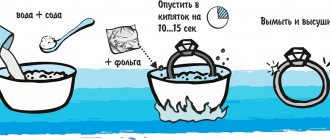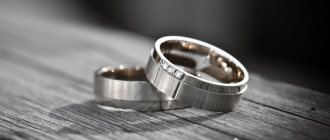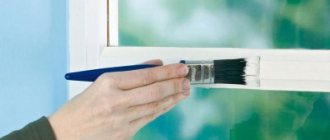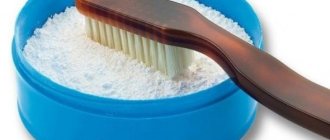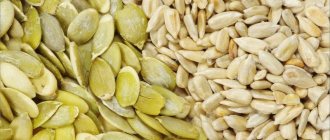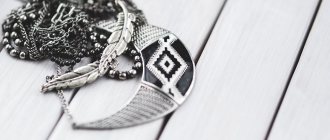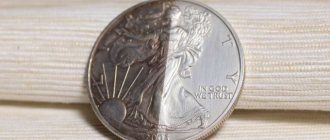How to clean copper? The relevance of this issue is explained by the fact that products made from this metal have been used by humanity for many centuries. For a long time, the value of this metal was so high that it was equal to gold. The development of technology has led to the fact that it was possible to significantly reduce the cost of copper production. This made it possible to make not only jewelry from this metal, but also dishes and interior items. The high popularity of this metal and alloys based on it is explained not only by its decorative effect, but also by its unique characteristics - high ductility, thermal conductivity, corrosion resistance, etc.
No one wants to use oxidized copper cookware.
Why do copper cookware need to be cleaned regularly?
Copper is one of the metals that can tarnish and oxidize.
For prevention, each time after using kitchen utensils, they must be thoroughly washed and wiped dry, and also avoid direct exposure to direct sunlight.
Regular cleaning will promptly eliminate the formation of plaque and the release of toxic substances.
This regular maintenance will extend the life of the copper.
How to clean copper from green deposits?
Green plaque on copper releases toxins and must be removed. Not all means can cope with its elimination.
There are several ways to remove corrosive plaque:
- The carbonated drink “Coca-Cola”, due to the presence of phosphoric acid in it, will clean and get rid of any contamination, especially green deposits. Pour this sweet fizzy drink into a small glass container and place a pot or frying pan in it for several days. This is a very original and at the same time effective method;
- ethyl alcohol mixed with turpentine and oxalic acid will also cope with green plaque. It is enough to saturate a soft sponge or rag with this liquid and apply it to the contaminated surface;
- Apply white chalk mixed with kerosene to a mushy state to the area of contamination or plaque formation. This is a great way to rub and add shine to a copper piece.
How to clean copper utensils from blackness?
Black plaque is also considered toxic. Requires mandatory elimination. However, such kitchen utensils can no longer be used for cooking.
To help get rid of blackness:
juice from half a lemon will remove the blackness if you rub it on the product, then rinse under the tap and wipe dry. If you don’t have lemon at home, you can replace it with citric acid, diluted with water to a paste.
hot soap solution diluted in a container. It is enough to immerse the dishes in it for a short amount of time. Then rinse lightly under running water and wipe dry.
with an ammonia solution . This procedure only needs to be carried out with caution, always in the open air to prevent poisoning from ammonia fumes. It is enough just to wet the sponge and wipe the product with it.
How to clean copper dishes from white deposits?
The white coating formed due to oxidation must be removed.
Several proven and reliable methods will help you quickly deal with it:
Tomato paste or ketchup, due to its high acid content, is good to use to remove white deposits and to give copper a reddish tint. It is enough to mix two tablespoons of paste with one tablespoon of salt and apply the resulting mixture to the product for 10 minutes with a sponge. Then rub in a circular motion over all the outer walls, remove the residue with a paper napkin.
glass of any fermented milk product , it is best to use sour milk, mix with 1 tablespoon of salt, soak a piece of flannel cloth or microfiber cloth with the resulting mixture. Rub the surface until the white coating is completely removed.
amidosulfuric acid , used for heavily ingrained plaque. When using it, it is important to follow safety precautions. This powder is quite aggressive, but quickly cleanses and adds shine to copper.
Cleaning copper with ammonia
Soak a rag in ammonia and apply it to the copper product. Then wipe with a clean rag to remove the ammonia. For a better effect, chalk chips are added to the alcohol. It mechanically scrubs and absorbs dirt.
Vaseline oil
Small specimens can be cleaned with oil. Vaseline is most suitable for this purpose. Before cleaning an antique copper coin, place a container of oil on the tile. To clean a coin, place it in a boiling oil liquid over low heat. In this way, you can quickly get rid of stains, rust and oxides on a collectible item. The oil has a very high boiling point, which speeds up the procedure. At the end of the process, the item is washed with ethyl alcohol.
Soda solution
You can use soda solutions on low-quality old objects that have good resistance to destruction. Before cleaning copper coins at home, add baking soda (2 tbsp) to a bowl and add plain water (5 tbsp). The resulting consistency after mixing should look like a slurry. This mass is applied to the surface of the product with small rubbing movements. Processing time will depend on the degree of contamination of the items and may take several weeks. You can speed up the procedure with additional brushing with a toothbrush. After the process is completed, the items are washed with running water and dried.
After cleaning your items at home, you need to dry them properly. For these purposes, paper towels are suitable, which should be folded in several layers and covered with them on both sides of the product. It is recommended to use only soft towels to avoid damaging an antique item or coin. Drying can be carried out using a drying cabinet heated to 100 °C. To slow down oxidative processes, the product is periodically wiped with crumpled black and white newspaper. Everyone has to choose how to clean copper items at home individually.
"Coca Cola"
Children's favorite drink can rid the surface of copper items of greenery, as well as other contaminants. To do this, coins are placed in a small container and filled with sweet fizzy drink. It is advisable to use glass containers. After a few days, all dirt and oxides will be successfully cleaned and things will acquire an attractive appearance. This effect occurs due to the presence of orthophosphoric acid in the effervescent drink. It is this that helps clean the metal from oxidizing greens and other contaminants. To speed up the process, you can place the container on a warm radiator or use another source of constant heating. This is the most original way for those interested in how to clean copper at home.
Cleaning copper with phosphoric acid
To clean copper from rust, phosphoric acid is used. The product is dipped in a 15–30% solution of orthophosphoric acid and applied with a brush or spray. Leave for a few minutes to take effect. Clean off plaque with a cotton cloth. If necessary, repeat the procedure.
Citrus
For convenience, you can cut off half of a citrus fruit and rub it on the coating. Having eliminated visible oxides and dirt, all that remains is to rinse the product with water.
Lemon juice
At home, you can use freshly squeezed lemon juice for cleaning. Soak a rag in the juice and wipe the product.
Cleaning with ketchup
This unexpected solution has proven itself in cleaning copper products from black deposits. Apply a generous amount of ketchup or tomato paste to the metal. Leave for an hour and wipe with a cotton rag. The fruit acids contained in tomatoes will not only get rid of plaque, but also restore the brightness of the metal.
Amidosulfuric acid
A solution of amidosulfuric acid effectively removes blackness and other types of contaminants from copper items. To perform cleaning, moisten a rag in an acid solution and rub the surface until the desired result is achieved.
Dry cleaning
The dry cleaning method involves the use of soft abrasives and is used in cases of heavy contamination. Chalk chips or coarse flour are used as abrasives. Dry abrasive is applied to a flannel cloth and polished in a circular motion.
If you clean copper using any of the above methods, strictly adhere to safety rules, carry out all work wearing protective gloves, and be sure to wear a respirator when working with acetic acid.
Possible consequences of oxidation processes
It is almost impossible to list all the possible negative consequences of contact oxidation. In general they can be classified:
- failure of electronic control units of the engine, transmission, body, brake system and other systems;
- failure of vehicle control units;
- software failures;
- sparking and the possibility of self-ignition in the contact area;
- loss of reliability of connectors and contacts;
- destruction of electrical wiring;
- difficulty in repairing electrical equipment.
One of the complex consequences of oxidation is the formation of the so-called “cold solder”. This occurs when the oxidation process penetrates the soldered contact. Externally, the element (resistor, capacitor, microcircuit, contact) appears to be securely soldered in, its electrical connection is beyond doubt.
In fact, the contact is destroyed from the inside and can break as a result of shaking the car or moving the position. Such a malfunction is extremely difficult to diagnose. You have to solder the entire board or connector using an industrial hair dryer. In addition to auto electrical, “cold soldering” is often found in computer and household appliances.
Mechanical cleaning of copper products
This type refers to professional cleaning and involves pre-soaking in distilled water. Then it is carefully impregnated with synthetic resin to strengthen the patina and prevent scratches during further cleaning.
Craftsmen use needles, brushes with minimal rigidity, manual and mechanical scrapers with different tip shapes, as well as metalworking tools.
This process is considered very long, painstaking, requiring patience and care.
Precautions when cleaning copper
When cleaning with aggressive agents, safety precautions must be observed:
- read the instructions carefully;
- use rubber gloves;
- if necessary, wear a protective mask to avoid burns to the respiratory tract caused by cleaning agent vapors;
- when mechanically cleaning copper, use plastic goggles to protect your eyes from foreign bodies;
- in case of contact with the skin or eyes, immediately rinse the area with water or seek medical attention;
- To avoid damage to copper, it is not recommended to leave the product in acid for a long time, and also to use iron brushes and abrasive substances.
What not to do
To avoid damaging the surface of the products, the following actions are prohibited:
- cleaning with abrasive materials;
- the use of chemicals that contain acids;
- heating objects in the presence of oxidizing substances or environments;
- removal of protective varnish coatings by chemical or mechanical means;
- leave copper objects in dusty places for a long time without carrying out wet cleaning.
It is important to strictly follow safety precautions when cleaning, especially when using strong chemicals. To remove contaminants, different cleaning methods can be used.
Corrosion of metals/alloys – what is it?
Rusting refers to the process of destruction of metal under the influence of negative factors in the environment. To one degree or another, all metals and alloys will rust, and as a result of this, rust and places of deterioration in integrity (namely, holes) appear on them. Over time, all non-metals can begin to deteriorate - an example is the aging of rubber or even plastic from exposure to oxygen, constant contact with water, and also due to temperature changes.
The main root cause of rusting can be considered the thermodynamic instability of the metal to the influence of physical factors or even substances of chemical origin that are present in the contact medium. Compared to iron, copper will oxidize much less, but with increasing temperature this process will greatly accelerate. If regularly exposed to an environment at temperatures above +105 degrees, any metal will rust several times faster.
Caring for Copper Cookware
There are several rules for the care and preservation of external and internal coatings:
- store dishes only in a dry cabinet, as humidity and heat contribute to the process of destruction and blackening;
- cannot be washed in the dishwasher, even at minimum temperature;
- do not keep empty dishes on a working stove;
- To avoid scratches, it is advisable to use wooden or plastic kitchen utensils;
- abrasive detergents containing chlorine, as well as metal brushes or sponges, are prohibited;
- Copper cookware does not like sudden temperature changes, so pouring boiling water into it is not recommended;
- food containing a large amount of acids, for example: vinegar, fruits or tomatoes - it is better to put them in another container.
The healing properties of copper have long been proven, but time has not been kind to it. Therefore, only with proper storage, cleaning and care will such dishes last a long time and delight you with their incredible color and radiant shine.
The main reasons for the accelerated oxidation of contacts in a car
Oxidation of contacts occurs in all electrical and electronic devices, including household and industrial appliances and electrical wiring. However, in a car the oxidation process occurs with greater intensity. The main reasons for accelerated oxidation of contacts in a car are as follows:
- increased humidity in vehicle systems;
- increased temperature in the engine compartment, accelerating the process of interaction with oxygen;
- presence of foreign ingredients (antifreeze, oil, mold, mildew);
- the flow of large currents leading to sparking and burning of contacts;
- interaction with the salt composition of road treatment.
The destruction of contacts is not always associated with the process of interaction with oxygen. For example, the destruction of battery terminal contacts is often explained by oxidation, although they are destroyed by acidic fumes. The destruction of a conductor by fungus and mold is closer to organic processes than traditional oxidation.
Effectively cleaning copper coins
Previously, small coins were made from a copper alloy. Today they are considered a rarity. Since a film often forms on the surface of coins, this reduces their value. To remove oxidation and return items to their original appearance, antique dealers use industrial cleaning products. With their help, you can not only return coins to their original condition, but also clean a copper pot or an antique basin.
Ways to clean copper at home:
- A pronounced yellow coating on coins indicates contact of the products with a lead surface. Such items can be treated with acetic acid solution.
- Citric acid powder will help remove the bright green film.
- Remove red deposits with a liquid containing ammonia.
Before cleaning a copper basin, dishes or coins that are considered rare, you need to study the recommended treatment time and the amount of active substance. If you overexpose a copper object in Trilon, acid, or rub it with sulfur ointment in excess, you can ruin antique items.
Boiling coins in soda solution
Baking soda and copper interact effectively with each other, returning the shine to metal products. To prepare the solution, take 1 liter of water and 10 tbsp. l. baking soda. You will also need a small saucepan and an old toothbrush.
The solution should be poured into a container and the products should be lowered into it. They should be covered with at least 2 cm of the solution. Place the pan on the fire and boil the contents for 20-30 minutes. Then you need to let the coins cool. Already cold products are treated with a toothbrush, removing remaining dirt.
Trilon B
Trilon B is another option for processing copper at home. This is a ready-made chemical mixture that is sold in jewelry stores. It is designed specifically for copper surfaces, does not destroy the metal, like some acids, and carefully cleans it of oxide.
Metal products are placed directly into a jar of the substance using plastic tweezers for 10-20 minutes. Then they are taken out and washed. If the oxide layer is too thick, the procedure will have to be repeated several times.
Kefir, vegetable oil
Kefir contains non-aggressive acids that gently clean the copper surface, leaving a light patina. To carry out the manipulation, all items should be placed in glass containers and filled with fermented milk product. Keep copper products in kefir for 50-60 minutes. Then you need to take them out, wash them under running water and dry them.
When using vegetable oil, you need to additionally take dishwashing detergent, a deep saucepan and plastic tweezers. Pour sunflower or olive oil up to 2 cm high into the bottom of the container and boil. Using tweezers, lower the coins into the pan and keep them on the fire for 10-20 minutes. Then remove the copper products, rinse with dishwashing detergent, wipe and dry.
Citric acid, vinegar
Dark stains on ancient coins can be easily removed with vinegar. First, prepare a solution with 0.5 liters of water, 1.5 tbsp. l. 9% vinegar and 1.5 tbsp. l. rock salt. Copper objects are dipped into the liquid and sent to the fire. It is advisable to boil the coins for 5-10 minutes, then remove them, rinse and wipe dry with cotton cloth.
If desired, vinegar can be replaced with citric acid or freshly squeezed juice. If lemon is used, the fruit should be cut in half and the pulp should be rubbed onto the copperware. Leave them in this state for 10-15 minutes, then rinse under running water.
Digestion
Cooking significantly speeds up the cleaning process. Typically a soda solution is used:
- Mix 1 tsp. soda and 100 ml of water.
- Bring the solution with the objects immersed in it to a boil.
- Hold the coins for about 5 minutes, then remove them with tweezers and evaluate the result. To do this, soak a piece of rag with vegetable oil and wipe the surface with it.
- If it doesn’t work the first time, you need to return the samples to the boiling solution and try again.
Advice: Practice on inexpensive items first, and then start cleaning more valuable ones.
How to clean a copper pot inside and outside?
The outer surface of the Turk can be cleaned using any of the methods presented above.
If you do not have experience working with aggressive chemicals and acids, use accessible and safe methods.
On the inside of the Turks, it is recommended to use softer substances so as not to damage the coating. For example, soda or ketchup.
Calculate the use of chemicals depending on the degree of contamination
Cleaning samovars and teapots
All methods are also suitable for cleaning copper samovars, teapots and Turks. It’s just that it’s a little more difficult to clean the inside, because limescale deposits appear there from boiling water. One proven method is to use potato peelings:
- After peeling the potatoes, leave the skins, wash them, pour them inside the dishes and pour boiling water over them.
- Boil water with potato peelings for three hours.
- Then drain the contents of the dishes and wash them in the usual way using detergent.
After such cleansing, you need to boil water in a copper bowl a couple of times, replacing it with a new one each time to remove any remaining plaque.
Another proven method is to use lemon zest. Skins from tangerines, oranges, and limes are also suitable. Then proceed like this:
- The skins are placed in the vessel, filling half the container with them. Instead of zest, you can take two packs of citric acid.
- Pour in a little water - do not fill it completely, otherwise the liquid will begin to splash out when boiling.
- Boil for half an hour, then drain the water and clean the walls of the product with a brush.
The procedure is repeated if necessary. You can also use store-bought products to descale teapots.
But detergents for washing machines and dishwashers are not suitable for copper cookware: they are more aggressive and can damage the copper surface. The selected purchased product is used strictly according to the instructions indicated on the package.
In the case of a samovar, it is recommended to disassemble it into its components before cleaning, since many different curved parts cannot be washed so easily by simple boiling.
If stains appear on copper utensils, you should not be upset; you can resort to different methods and means that give good results. It is quite easy to restore a copper surface to its former beauty.
Clean a copper basin at home
As a rule, a copper basin is used to make jam. Such dishes have good thermal conductivity, antiseptic properties, are safe for humans, and when cooking the jam practically does not stick to the walls.
If the jam is still burnt, the copper basin can be cleaned with vinegar dough. For this ancient method, you need to knead the dough by mixing flour and table vinegar. Next, the dough is rolled out thinly and placed on the dirt.
After the mixture dries, carefully remove it. The vinegar paste absorbs dirt, making the surface perfectly clean.
How to restore shine
Having wiped off plaque and dirt from a copper product, you need to restore the original shine to maintain decorative properties. There are several polishing options that can be easily performed at home.
Crumpled newspaper
The easiest and most effective way to restore its original shine is to polish it with regular newspaper. You need to roll up a couple of sheets of newspaper into a ball and wipe the tarnished areas with it.
Constantly using this method, you can quickly restore the condition of the products.
Vinegar dough
A dough mixed from vinegar essence and wheat flour is suitable not only for combating stains, but also for polishing. The only difference is that to polish the dough you need to add a pinch of table salt. A mixture of these components is applied to the surface of the object and left until dry. To avoid damaging the coating, it is important to ensure that the salt particles are dissolved before application.
Hydrochloric acid solution
It is recommended to use hydrochloric acid in the most extreme situations. A powerful solution that restores shine after rubbing the surface. For safety reasons, when working with the substance, you need to wear protective gloves and a mask, and open the windows in the room for ventilation.
Kerosene and chalk
A mixture of kerosene and chalk chips is applied to a soft sponge and the metal coating is wiped until a characteristic shine is formed. This processing method is suitable for cleaning and finishing products.
Using toothpaste or powder
Abrasives, including toothpaste and powder, contain ingredients that remove tarnish from metal surfaces. The composition is applied to the darkened areas and rubbed in with light force with a soft sponge. Then all that remains is to rinse the residue with heated water and wipe the coating dry.
How to make copper products shine
Cleaning copper products to a shine is possible in the following ways:
- applying lemon juice, citric acid solution;
- polishing with special pastes;
- galvanic method, using copper as an anode;
- by heating a mixture based on citrus juices inside a copper container.
Use of chemicals
Sulfuric acid removes darkening and green deposits from the surface layer of copper very well. It is mixed in equal proportions with water and a copper bracelet or other objects are placed in the liquid. When the seething begins, take the item out and wipe it well with a soft cloth. Then the item is laid out on a flat surface to dry. This cleaning method returns the product to its original shine.
Important! When working with sulfuric acid and other aggressive substances, put rubber gloves on your hands, and protect your respiratory organs with a respirator.
Another cleaning method is to use the drug Trilon-B. The substance is stirred in water in a ratio of 1:10. Afterwards, the copper product is lowered into the resulting liquid and observed. When the required degree of cleanliness is achieved, the item is taken out and washed with clean water.
Useful tips and tricks for caring for copper items
It is worth adhering to the following recommendations to maintain the shine of copper products for a long time:
- To preserve the natural copper shine of objects for a long time, you can use a protective varnish coating. For example, cheap copper jewelry can be coated with clear nail polish. This method allows you to isolate the product from contact with the air atmosphere and human skin, which will preserve its shine for a long time. Besides nail polish, you can also use beeswax. This product can be found in relevant stores.
- Do not use abrasives or steel objects when cleaning copper metal as they are harder than soft copper and can severely scratch the product.
- Heat and humidity are the enemies of copper cookware, as they significantly accelerate their destruction and blackening. To avoid continued exposure to these factors, store the product under appropriate conditions, such as a dry, ventilated cabinet.
- It is not recommended to cook food containing a lot of acids in copper cookware at high temperatures. Products containing acids, such as vinegar, fruits, tomatoes and others, cause serious harm to copper products.
- Most decorative items are coated with a protective varnish layer. Such items should be washed only with warm water and soap and do not use abrasive materials or polish these items, as all this can damage the protective coating. In addition, products with a protective coating require special care, so it is recommended to follow the manufacturer's instructions.
- Some copper food utensils have a protective coating that must be removed before using the utensils for their intended purpose. There are two ways to remove the coating: place the product in boiling water with a small amount of baking soda, or thoroughly wipe the product with a cotton cloth soaked in alcohol or acetone, and then rinse under running water.
- Do not forget to wipe copper products with a damp, clean cloth, not allowing dust and dirt to accumulate on them.
Home methods for cleaning blackness on copper products should be used from time to time as needed, but you need to understand that the items will become thinner each time .
Sources
- https://hozzi.ru/chistka/chem-med
- https://hoznauka.ru/veshhi/dragotsennosti/kak-pochistit-med.html
- https://posudaa.ru/poleznye-sovety/chem-pochistit-mednuyu-v-domashnih-usloviyah
- https://sdelai-lestnicu.ru/uborka/cem-cistit-med-v-domasnih-usloviah-27-bystryh-sredstv-i-metodov
- https://met-all.org/cvetmet-splavy/med/chem-kak-pochistit-med-v-domashnih-usloviyah.html
- https://metalloy.ru/obrabotka/chistka/medi-metody
- https://instanko.ru/drugoe/chem-chistit-med.html
- https://magnetline.ru/metally-i-splavy/kak-pochistit-med-v-domashnih-usloviyah.html
- https://366.ru/articles/5-sposobov-ukrepit-sosudy/
- https://uborka.co/chistka/kak-pochistit-izdeliya-iz-medi
